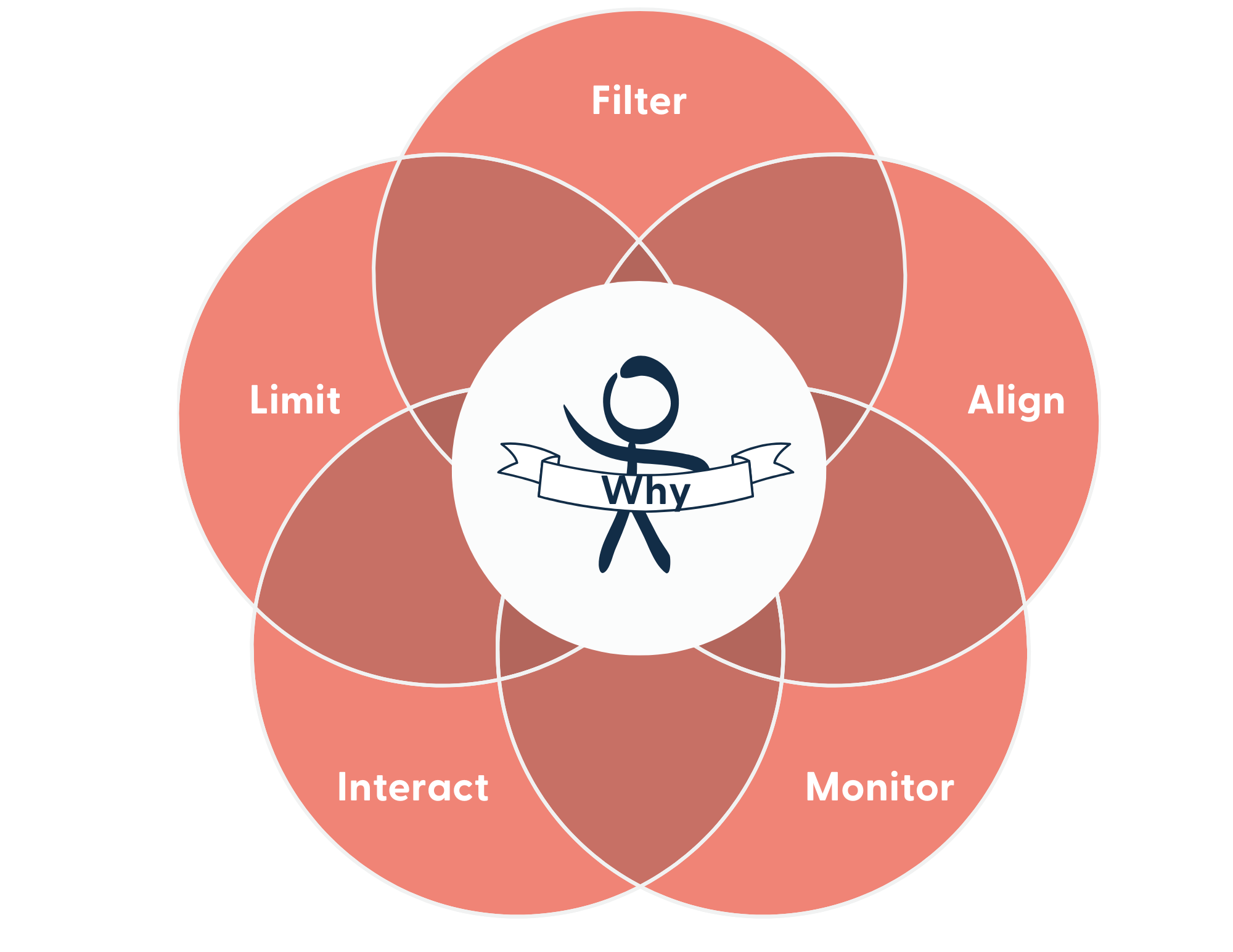What a privilege to be working with the St. Francis community!
I’m Lisa Honold and I’ll be hosting Internet Safety events for students (3rd-5th grade and 6th-8th grade), teachers and parent night on Wednesday January 22, 2025.
I hope to meet you!
We’ll be talking about:
Protecting your child’s digital reputation
Understanding the popular apps youth are using and the features available
Learning about the algorithms and how they impact what we see online
Artificial intelligence (AI) like Chat GPT and AI photo apps
Bring your questions! There will be time for Q&A.
Your questions
Are there any apps you recommend to help me supervise what my kids are doing online - a filtering or monitoring app?
I love this question because monitoring and filtering are both important!
Before we dive into the specifics, the thing to remember is to include your child in these conversations. Don’t just set up expectations or a Technology Contract without their input. They need to understand why you’re doing this and you need to be flexible in your expectations. There are some rules you’ll have as non-negotiable (for example: phones out of the BR at night) and some rules or expectations that can be flexible (for example: the amount of time they can play games or socialize online on the weekends or what part of the day is designated for screens).
What’s a filter?
An internet filter is like a front door that you can shut when bad content tries to come in. Every home network should have a filter because you don’t want all the garbage coming through your door. You need to make sure you’re filtering out the adult content, the explicit content, the things that your child isn’t ready for.
There are two ways to filter content.. The Human way and Tech way.
What can I do to monitor my child’s behavior online?
Monitoring your child’s behavior online is like a camera attached to your front door. It lets you see who is out there, wanting to interact with your child, and what their intentions are.
Just like Filtering, Monitoring has a Human side and a Tech side. From a human side - Pay attention to which apps they’re downloading, where they’re spending time. Sit next to them and look over their shoulder. Take their phone and review it. Photos, apps, what’s going on. And the tech side - consider a monitoring app (not a spy app that sends you everything your child ever does, but an app that send parental alerts when your child receives a photo with nudity or the eggplant emoji (Yes, that’s a problem!)
We have lots of specific advice and recommendations - take a look at our Five Circles of Safety handbook for more information on filtering the internet, blocking sites and monitoring what your kids are doing online.
How can I encourage my kids to take a break from screens? When I try, they say they’re “bored”.
There is nothing wrong with being bored - it’s when the best creative ideas come to us.
But when kids are forced to try a new habit, like not using their screens, it’s uncomfortable. They’re disrupting a pattern and it’s hard to think of anything else to do.
You can help in three ways:
Talk to them about your experience starting new habits and how uncomfortable it is at first, whether it’s deciding to go to the gym to exercise or keeping a gratitude journal for 30 days or flossing your teeth. It’s hard at first!
Be a role model. Put down your own devices and take a break.
Create a list of No-cost Screen-Free Activities with your kids and remind them of the things they could do when they’re bored. Sometimes it’s helpful to have an extra chore they could do too, just in case they still say they’re bored, then you can say, “Oh good - I’ve got a chore for you!”
How do you start to let go of control when you’ve been extremely strict about phones/social media/online access and now you’ve got teenagers? What are your suggestions for how to gently ramp things up?
There’s a give and take that happens as teens grow up. I appreciate this question because you recognize your 13+ year old teen might need more access to social media for things like a Snapchat group for the baseball team or an Instagram group message for band practice.
My advice:
Pick one app to start - spoiler alert - there is no 100% safe social media app. If there’s an app the school is using, choose that one (and if your child is under 13, remind your school that kids shouldn’t have access to social media according to the Terms of Service.)
Set up a Technology Contract with your child - talk through when they should use their phone and when it should be phone-free time. For example, many families consider dinner time sacred and everyone leaves their phone in another room.
In the Tech Contract, set up the expectation that you have access to the passwords and will do random spot checks.
Use a filtering/monitoring system so you get alerts when your child is sending or receiving potentially inappropriate messages. I recommend Bark - it’s a subscription for your family that sends parental alerts when things might be going sideways. These real-time parental alerts help you to have ongoing conversations as needed about your expectations and what’s appropriate/inappropriate content.
How do I talk to my kids about sexting (“sending nudes”), scams like sextortion and the bad things that can happen?
Our partners at Thorn give a good overview of online grooming, CSAM (child sexual abuse material) and sextortion here and you’ll find the parent guide on sexting, go here.
As hard as this subject is to talk about, it’s important to role play scenarios where someone asks for a nude so your child can practice setting boundaries and saying no. Here’s the teen guide to help you practice.
Watch this with your teen
The Dove “Reverse selfie” video features a 13-year-old girl who drastically edited a picture of herself before posting it online.
The film plays backwards, starting with the posted selfie, then reversing the various tweaks and staging to finally reveal the young girl behind the picture.
Ask: Do you know people who feel pressured to look “better” online (older, sexier, fuller lips)? Do you know kids who use beauty filters regularly?
Fill out the form below to ask questions and start a conversation anonymously.
Resources for you
-
The Five Circles of Cyber Safety
We’ve put together an overview of what parents and caregivers can do to keep connected with their children and protect them from online harms.
It’s called the Five Circles of Online Safety and the actions to take spell out “FAMILY”.
-
Technology Contracts
A Technology Contract (Tech Contract) is an agreement between parents and kids that lists the expectations and rules for the devices kids are going to be using.
Sometimes it’s also called a Family Media Agreement. This contract can be adjusted and modified as kids grow up and want more freedom.
-
Digital Milestones - Developmental Stages
Every parent wants to know WHEN kids should have access to smartphones, tablets, social media and we’ve got all the answers you need in this Guide to Digital Milestones for Kids.
You’ll learn what you should be doing to protect your kids online and prepare for their new freedoms at every age.
-
Snapchat's new "My AI" chatbot
Snapchat is the first social media platform to launch a new chatbot running the latest version of OpenAI's GPT technology. It’s called “My AI”.
Here’s the reprehensible part - a quote from Snapchat taking zero responsibility for what their AI might do. Our kids don’t need to be exposed to unpredictable features that cannot be monitored.
-
First phone options for kids that are safer
Before you go buy the latest smartphone or even shuffle through the junk drawer to revive your old smartphone, take a minute to identify your needs and your child’s needs.
Your child probably doesn’t NEED to own a smartphone with access to the 4 billion people on the internet with all levels of good to bad ideas. Especially if they’re 12 or under.
-
Sextortion - What You Need to Know
Sextortion is when someone coerces you to send explicit videos or photos online then threatens to share them publicly if you don’t give them what they want - either pay them, give them more explicit images or meet in person.
Sextortion is a serious crime and potentially life-threatening issue. Parents and teachers need to know how to help kids avoid it and all of the repercussions that come with it.
-
Parental controls for TikTok, YouTube and Snapchat
Once you’ve said “yes” to a social media platform like TikTok or Snapchat for your teen, are there parental controls you can put on their account?
What about parental controls for YouTube?
-
Safety and parental controls on Instagram
How can you help teens have a healthier experience on social media? And how can you set yourself up for a healthier experience?
There are two layers of protection to look at:
What you do outside of Instagram
What you can do inside of Instagram




